
Skate or Die! is a skateboarding game released by Electronic Arts (EA) in 1987 for the Commodore 64. It is EA's first internally developed game. Ports for the Apple IIGS, MS-DOS, Amstrad CPC, and ZX Spectrum were released the following years. It was ported to the Nintendo Entertainment System (NES) by Konami, published under the company's Ultra Games branding.

Abrams Battle Tank is a video game developed by Dynamix and published by Electronic Arts in 1988 for MS-DOS. Designed by Damon Slye, the game is a 3D vehicle simulation of the M1 Abrams tank. The 1991 Sega Genesis port by Realtime Games Software was renamed to M-1 Abrams Battle Tank.

Sid Meier's Pirates! is a video game created by Sid Meier for the Commodore 64 and published by MicroProse in 1987. It was the first game to include the name "Sid Meier" in its title as an effort by MicroProse to attract fans of Meier's earlier games, most of which were combat vehicle simulation video games. The game is a simulation of the life of a pirate, a privateer, or a pirate hunter in the 16th, 17th and 18th centuries. It was widely ported to other systems.

The Ancient Art of War is a video game designed by Dave and Barry Murry, developed by Evryware, and published by Broderbund in 1984. It is recognized as one of the first real-time strategy or real-time tactics games.
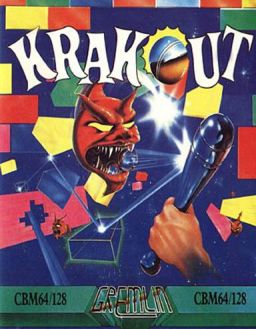
Krakout is a Breakout clone that was released for the ZX Spectrum, Amstrad CPC, BBC Micro, Commodore 64, Thomson computers and MSX platforms in 1987. One of the wave of enhanced Breakout variants to emerge in the wake of Arkanoid, its key distinctions are that gameplay is horizontal in layout, and that it allows the player to select the acceleration characteristics of the bat before playing. It was written by Andy Green and Rob Toone and published by Gremlin Graphics. The music was composed by Ben Daglish.

Roadwar 2000 is a 1986 video game published by Strategic Simulations, Inc. It is a turn-based strategy game set in a post-apocalyptic future which resembles the world portrayed in the Mad Max films.

GATO is a real-time submarine simulator first published in 1984 by Spectrum HoloByte for DOS. It simulates combat operations aboard the Gato-class submarine USS Growler (SS-215) in the Pacific Theater of World War II. GATO was later ported to the Apple IIe, Atari ST, and Macintosh. In 1987, Atari Corporation published a version on cartridge for the Atari 8-bit family, to coincide with the launch of the Atari XEGS.

Strike Fleet is a 1988 video game developed by Lucasfilm Games and published by Electronic Arts. It was released for the Amiga, Apple II, Atari ST, Commodore 64, and MS-DOS. Strike Fleet is the unofficial sequel to the war game PHM: Pegasus.
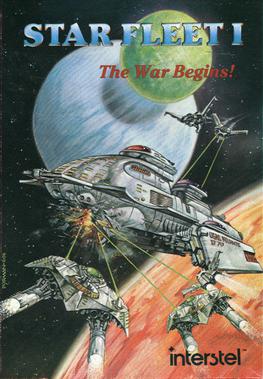
Starfleet I: The War Begins is a 1984 strategy computer game designed by Trevor Sorensen and developed by Interstel. It was released for Apple II, DOS and Commodore 64. Versions for the Commodore 128, Atari ST and Atari 8-bit family were released in 1986 and versions for the Amiga and Macintosh were released in 1987. The game was successful enough to spawn sequels which are collectively known as the Star Fleet series.

Test Drive is a racing video game developed by Distinctive Software and published by Accolade, released in 1987 for the Amiga, Atari ST, Commodore 64, and DOS, in 1988 for the Apple II, and later ported for the PC-98 in 1989. It is the first game in the Test Drive series.
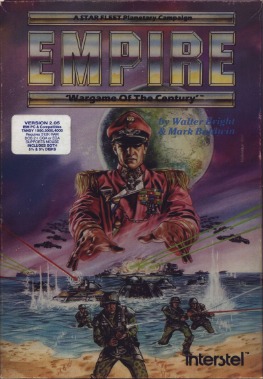
Empire: Wargame of the Century is a video game based on Empire developed by Walter Bright and published by Interstel Corporation in 1987.

PHM Pegasus is a ship simulation and action game released for the Commodore 64, Apple II, DOS, Amstrad CPC, and ZX Spectrum. The title refers to USS Pegasus (PHM-1), one of the Pegasus-class hydrofoils which were used by the U.S. Navy in the 1970s.

Star Command is a video game released by Strategic Simulations in 1988.
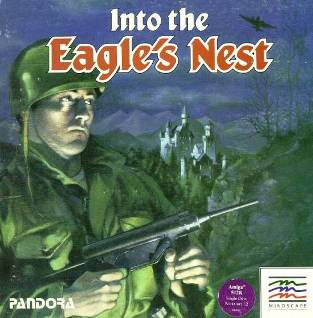
Into the Eagle's Nest is a video game developed by Pandora and published for Amiga, Amstrad CPC, Apple II, Atari 8-bit family, Atari ST, Commodore 64, IBM PC, and ZX Spectrum starting in 1987.

Macadam Bumper is a video pinball simulation construction set developed by ERE Informatique in France. It was first released for 8-bit computers in 1985, the Atari ST in 1986 and MS-DOS in 1987. The Atari ST and MS-DOS versions were released in the US as Pinball Wizard in 1988 by Accolade.

Skyfox II: The Cygnus Conflict is a space combat computer game developed by Dynamix and published by Electronic Arts in 1987 for the Commodore 64 as a sequel to the original Skyfox for the Apple II. It was ported to the Amiga, Atari ST, and MS-DOS. The creator of Skyfox, Ray Tobey, was not involved in this game.
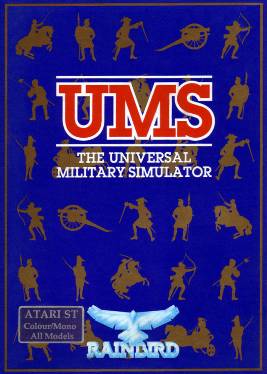
The Universal Military Simulator is a computer game developed by Rainbird Software in 1987 for the Macintosh, Tandy 4000, and IBM PC compatibles. In 1988, both Atari ST, Amiga versions were released. The game was created by Ezra Sidran. The PC and Amiga versions were ported by Ed Isenberg. The game spawned two sequels: UMS II: Nations at War and The War College: Universal Military Simulator 3.

Power At Sea is a video game developed by Distinctive Software and published by Accolade in 1988 for the Commodore 64.

PT-109 is a naval simulation video game developed by Digital Illusions and Spectrum HoloByte in 1987 for the Macintosh and MS-DOS. This game is roughly based on the events involving the Motor Torpedo Boat PT-109.

Falcon is a combat flight simulator video game and the first official entry in the Falcon series of the F-16 jet fighter's simulators by Spectrum HoloByte. Originally developed by Sphere for Macintosh and MS-DOS in 1987 and ported to several platforms between 1988 and 1992, the game earned commercial success and critical acclaim.





















